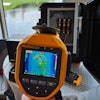As traditional manufacturing in America limps along, many wonder what will help keep the industry, and the nation, competitive in the 21st century.
One answer: nanotechnology.
Most agree that the U.S. will increasingly lose ground to lower-wage countries in what has typically been the more transient sectors of manufacturing, such as apparel - simple, low-skill manufacturing. Likewise, many contend the U.S. will maintain its leadership position the leader in high-tech, highly skilled manufacturing - and at the forefront of that is likely to be nano.
Nanotechnology is a set of tools and processes to manipulate matter on a molecular level. In other words, making things really, really small. The processes can be applied to almost any manufactured product, like feather-weight protective clothing to computer chips that are nearly invisible.
According to a September 2006 report from the American Electronics Association (AeA), high-tech manufacturing employment in the U.S. added 33,100 net jobs between January and June of 2006, raising total employment to 1.37 million jobs, a 2.5 percent increase in the sector.
Meanwhile, according to data from Lux Research, by 2014, 10 million manufacturing jobs worldwide will involve nanotechnology, comprising 11 percent of the total manufacturing jobs.
Michael Holman, Ph.D. and Senior Analyst for Lux, notes the importance of developing new materials and innovations, along with collaboration, to help keep the U.S. competitive.
“It is tricky to find the right balance on R&D spending and the need to maintain a healthy balance sheet in the near term,” Holman said. “It is increasingly important that companies be able to find innovations outside their own research facilities.”
An example of the utilization of nanotechnology, according to Holman, is a development by Boeing, which is now utilizing nano tubes in its manufacturing processes. Boeing is currently active in researching the structural performance of carbon fiber with the use of carbon nanotubes. The company's 7E7 is the first commercial airplane using carbon fiber for its fuselage and wing structure.
“We need to rely on new materials and innovation to keep the U.S. competitive,” Holman said.
A study conducted by Lux entitled “Sizing Nanotechnology’s Value Chain,” notes sales of products incorporating emerging nanotechnology will increase from less than 0.1 percent of global manufacturing output in 2004 to 15 percent in 2014, totaling $2.6 trillion.
Of course, there’s at least one obvious obstacle to the scenario of the U.S. dominating the nano-scene, an obstacle that is already giving manufacturers fits today: finding workers.
Indeed, the key to continued success in this market will be access to a highly skilled workforce, according to Josh James, Senior Manager of Research and Industry Analysis for the AeA.
“High-tech manufacturing is still having trouble finding qualified people,” James said. “The universities aren’t graduating enough scientists and engineers.”
None of this is to say that the U.S. should adopt a defeatist attitude and more or less abandon traditional manufacturing.
“If we continue to outsource simple manufacturing, we lose a foundation and create opportunities for the competition to enter the market,” said Thomas Roemer, Assistant Professor of Innovation, Technology and Operations Management at the Rady School of Management, University of California, San Diego. “Ten years from now, there’s a very good chance that Chinese cars will be in the market,” he said, citing the example of Honda’s simple beginnings of building small motorcycles, developing into a major auto manufacturer 50 years later. “We cannot just give up on manufacturing in the country.”
Dan Meckstroth, Chief Economist for the Manufacturers Alliance/MAPI, agrees that more basic forms of manufacturing shouldn’t be ignored.
“We shouldn’t try to pick technologies,” Meckstroth said. “It isn’t going to be the savior of manufacturing. You can’t have an economy without glass and steel.”
And while it’s true many areas of high-tech manufacturing are doing well, Meckstroth also notes that other forms, like the transportation and auto industries, are still making significant contributions to the industry as a whole.
“When you add it all up, it wasn’t a bad year for auto manufacturing,” Meckstroth said, citing the impact of companies like Honda, Toyota and Hyundai building plants in the U.S.
Meckstroth suggests the manufacturing industry focus on higher-end and value-added technologies and focus less on low-cost and low-wage assembly. He foresees a shift toward more high-skilled manufacturing, but not necessarily high-tech manufacturing.
“It’s not strictly electronics and pharmaceuticals,” Meckstroth said. “It’s not the majority of manufacturing. If you give up on it, you give up on most of manufacturing.”
To comment on this stiory email us at [email protected]






















